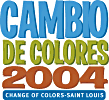Last updated:
May 19, 2004
Recent press releases:
Press release, February 11, 2004
Nota de prensa, 13 de febrero, 2004
|
About the conference
February 2003: Cambio de Colores has just
obtained an
Exceptional Program Award
from the the Association
for Continuing Higher Education!
(This document is also available
in PDF format�190Kb.)
�Cambio de Colores (Change
of Colors) in Missouri� is
an �annual conference that focuses on issues related to current Latino
immigration to the state in particular and the Midwest in
general. �The main objectives of the conference are:
-
To
assess the changes brought about by the presence
of new Latino settlers in every region of the state.
-
To
inform about� the multiple contributions�economic, social, and cultural�that
these new Missourians are bringing to many a community and to the
state as a whole.
-
To
understand the opportunities that this demographic
change brings to the state, its people, communities, businesses,
and educational
institutions.
-
To
provide a forum to discuss the change and growth
challenges posed to institutions and people �both new and old Missourians.
-
To
share relevant scholarship and best practices,
and identify knowledge and service gaps that need addressing.
The conferences convene academic research and extension specialists,
public and private service providers, grassroots organizations, state
and local government institutions, politicians, and newcomers themselves.
The conference is sponsored by the University of Missouri,
in cooperation with community and state partners.
The Hispanic
and Latin American Faculty & Staff Association
of the University of Missouri-Columbia (HLAFSA), established in late
1999, took a principal role in creating and leading �these conferences,
with the enthusiastic support of the University of Missouri
System institutions, and the collaboration
of many organizations in our state.
Over 250 people attended a groundbreaking, three-day event that
took place in March 2002 at the University of Missouri-Columbia, �Cambio
de colores (change of colors). Latinos in Missouri:
A call to action!� �A synthesis of the experiences, facts and
knowledge derived from �this conference is Cambio de Colores.
Immigration of Latinos to Missouri, which remains a state-of-the-art
publication.
The 2003 conference, �Cambio de colores (change
of colors). Latinos in Missouri: Neighbors in Urban and Rural
Communities�,
convened on the campus of the University of Missouri-Kansas
City.� Registered participants numbered 296 for this three-day
event.
The participation in these events is demonstrating �the relevance
and the urgency of addressing today the challenges
and the opportunities that arise in Missouri and
other Midwestern states, as Latino and other newcomers settle as
workers, families and members of communities.
The third conference, �Cambio de colores (change
of colors). Latinos in Missouri: Gateway to a New Community,� will
take place at the University of Missouri-St.� Louis, in March 10-12, 2004.� Preparations are well under
way, with the added support of the vibrant St. Louis Hispanic community,
other higher education institutions, and many organizations from
our state.� The themes addressed include change, communities,
youth, education, health, and civil rights.
Some Fast Facts about Latinos...
-
A 2000 report,
drawn from the National Agricultural
Workers Survey, showed 81 percent of America's
crop workers are foreign-born, overwhelmingly
from Mexico.
Of these workers, 14% own or are buying a home
with they work.
-
According to an
Urban Institute report:� Self-employment is higher among immigrants
than among native-born Americans.
-
Immigrants are
substantially overrepresented among workers
who are paid the least and are most in need of training to
improve their skills and earnings.
Nearly half (48 percent) of all immigrant
workers earned less than 200 percent of the minimum wage,
compared with 32 percent of native
workers. The average low-wage immigrant
worker earned $14,400 in 2001.
-
Immigrant Families
Have Important Strengths. According to
a 1999 National Survey of America�s Families (NSAF), policymakers believe that children will
do better in two-parent working families. A higher proportion of
children of immigrants live in two-parent families (80 percent compared
with 70 percent of children in native families). The strength of
immigrant families extends to their children's behavior, school engagement
and share of children taking after-school lessons. On these measures,
children of immigrants do as well as or better than their native
counterparts.
This will be the third Cambio de Colores (Change of Colors)
- Latinos in Missouri conference.
Please visit
the archival web sites of the two previous meetings:
|
